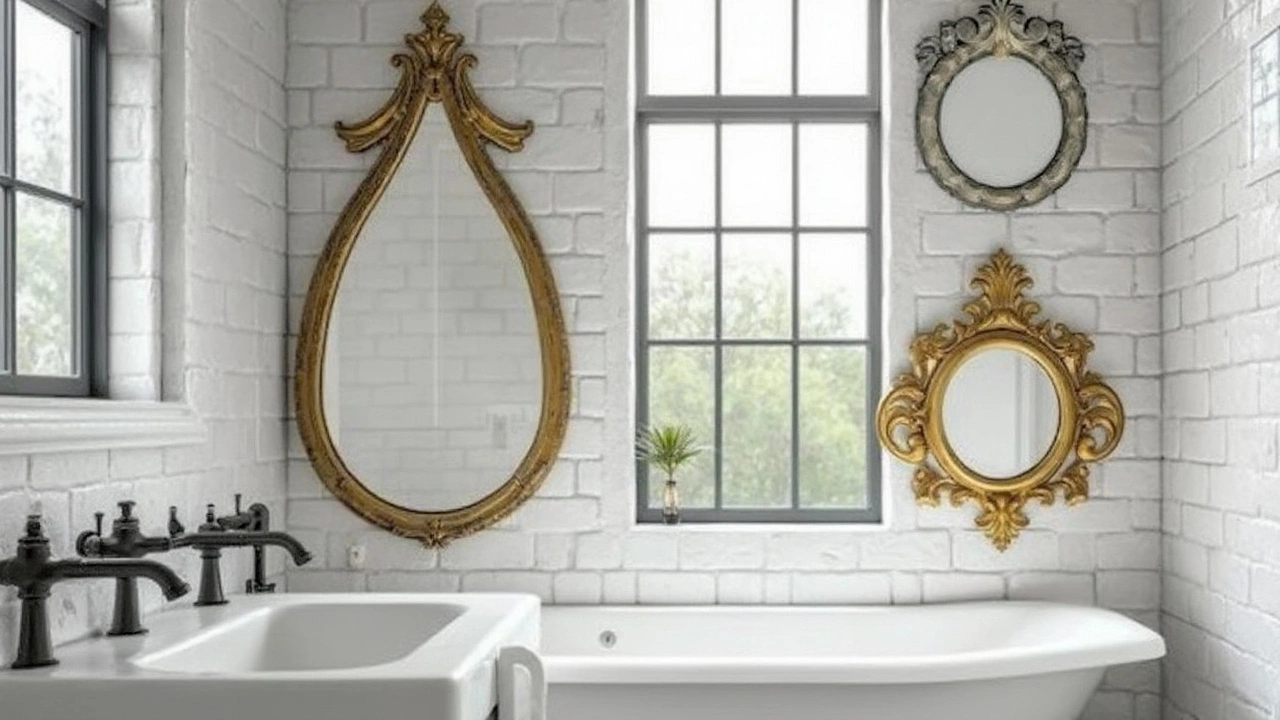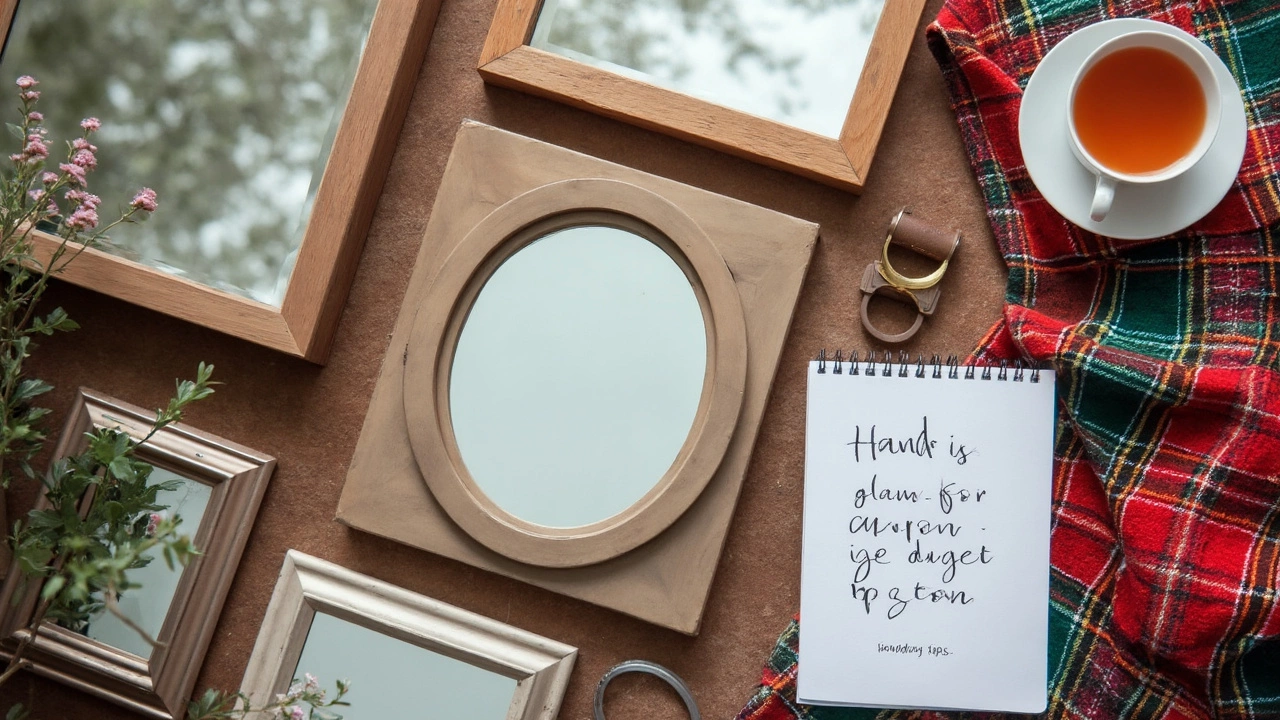Mirror Cost: What You'll Really Pay for a Good One

Ever wonder why one mirror costs twenty bucks, and another looks the same but costs two hundred? It’s not just a brand slap or marketing trick. There’s real stuff happening behind the scenes in how mirrors get made and what sets one apart from another.
If you’re shopping for a good quality mirror, it actually pays to know what you’re getting for your cash. The type of glass, the way it’s finished, and even the little details like how smooth the edges are—all these can bump up the price or make a cheaper mirror not worth the hassle in the long run. Sometimes a cheap mirror goes cloudy after a year, while a better one stays clear for a decade.
The basics first: a simple, decent bathroom mirror (nothing fancy) will usually run you $35 to $70 at most big box stores. You want something bigger, or a stylish frame for your living room? You could be looking at $150 and up—sometimes way up, if you want something custom or super-trendy. And if safety glass or anti-fog coatings matter to you, tack on even more.
Most people get stuck trying to balance price with quality, but knowing just a little about construction and features will help you nail down what’s worth paying for—and what isn’t. Let’s break down what really matters when it comes to buying a mirror, so you spend smart and avoid regrets.
- What Makes a Mirror High Quality?
- Typical Price Ranges for Different Kinds of Mirrors
- What Impacts Mirror Prices?
- Where to Buy—And How to Score a Deal
- What to Look Out For: Tips That Save Money and Hassle
What Makes a Mirror High Quality?
If you’ve ever had a mirror start peeling, clouding, or warping, you know not all mirrors are created equal. The secret stuff that makes a quality mirror goes way past what you can spot on the store shelf.
First up, it’s about the glass itself. Good mirrors use glass that’s super flat and free from any ripples. If the glass is wavy or thin, you’ll end up with a funhouse look when you check yourself out, even if it’s brand new. Most solid mirrors use glass that’s at least 1/4 inch thick. Thinner glass—like 1/8 inch—tends to flex, distort, and is just easier to break.
Then there’s the reflective coating. High-quality mirrors usually use a layer of real silver or aluminum on the back of the glass. Silver gives the best reflectivity, but it costs a bit more. Cheap mirrors might use tin or a thin layer of aluminum, which gives you that faded or almost “dirty” look over time. Better mirrors seal those layers with extra coatings to keep out moisture and extend that like-new look for years.
Ever noticed the edges? A well-made mirror has polished, smoothed, or beveled edges. Sharp or raw-cut edges chip easily—or worse, they’re a straight-up safety risk. You’ll see extra edge work in pricier mirrors or ones meant for living areas, while simple bathroom mirrors usually just have a clean grind.
Backing matters too. A good mirror has a thick, painted backing that blocks out moisture, slows down those ugly black spots (that’s called desilvering), and helps the mirror last. In bathrooms, mirrors with vinyl safety backing are smart since they hold together if the glass ever cracks.
Here’s a quick look at what separates the good from the cheap stuff:
| Feature | High Quality | Low Quality |
|---|---|---|
| Glass Thickness | 1/4 inch or more | 1/8 inch or less |
| Reflective Coating | Silver or aluminum, thickly applied | Thin aluminum or tin |
| Edge Finish | Polished/beveled | Raw or sharp cut |
| Backing | Painted, sometimes vinyl safety layer | Little or no protection |
| Clarity/Distortion | Flat, true reflection | Wavy or distorted |
If you want a mirror to last longer than a couple of years, make sure it checks those boxes. Look for accurate product specs or even ask in-store staff about glass thickness and the type of reflective coating. It’s worth paying a little extra for features you’ll notice every single day.
Typical Price Ranges for Different Kinds of Mirrors
Walk into any store or scroll online, and it’s easy to get hit by price shock. Some mirrors look almost identical but are miles apart in cost. Here’s a no-nonsense breakdown so you’ll know what’s normal and what’s way out there.
| Type of Mirror | Typical Price Range (USD) | Features |
|---|---|---|
| Basic Frameless Bathroom Mirror (small to mid-size) | $20–$60 | Plain edges, thin glass, basic backing |
| Framed Decorative Mirror (living room, entryway) | $60–$250 | Sturdy frame, thicker glass, more style |
| Full-Length Mirror | $50–$300 | Can be wall-mounted or standing, optional frame |
| Custom Cut Mirror | $125–$500+ | Tailored size, specialty shapes, better backing |
| High-End/Smart Mirrors | $300–$1,500+ | Lights, anti-fog, Bluetooth, fancy tech |
"The right mirror can elevate a space for years, but buying on price alone leaves most people replacing mirrors more often than they expect." — Tim McGaughey, owner of Glass Doctor franchises in Texas.
So why the big swings? For starters, the size matters more than you’d think. Every extra inch cranks up cost, especially for high-clarity glass. A standard, unframed bathroom mirror that’ll do the job might cost under $40, but a framed version in the same size can run you double, mostly because of the frame quality.
Larger living room mirrors and full-length options need sturdier backing to stand up without warping. That’s why a budget mirror from a discount store can sometimes feel bendy or distort your reflection. Name brands also ramp up the price if you want heavy-duty safety glass or anti-shatter coatings for households with kids or pets.
Then there are the bells and whistles. Smart mirrors can have LED lights, fog resistance, or touch controls. Some even connect to your phone or show you the weather. Those upgrades move the price into the hundreds, sometimes into the thousands for luxury models.
Bottom line: for a solid mirror cost, plan for at least $50 if you want decent glass, and splurge more if you need custom sizes or advanced features. Watch for seasonal sales—big retailers usually knock 15-25% off mirrors during spring and back-to-school events.

What Impacts Mirror Prices?
Ever notice how two mirrors the same size can have completely different price tags? Some of it’s obvious, like size, but there’s more going on behind those digits.
First off, the quality and thickness of the glass matter a lot. Cheap mirrors usually use thin glass, like 1/8 inch, which can warp or give you that "funhouse" look. Quality mirrors use glass that’s at least 1/4 inch thick. That extra heft keeps your reflection accurate and helps prevent cracks or breakage. Frameless mirrors can cost less, but framed mirrors with materials like solid wood or metal can add both style and dollars to your bill.
The backing is another big deal. Most mirrors have a layer of silver nitrate or aluminum. Silver backing usually has better clarity and lasts longer, but it costs more. Poor-quality backing can peel or allow moisture in, which makes the surface cloudy over time. For bathrooms or humid places, you really want a well-sealed backing. Some newer mirrors also add anti-fog or anti-scratch coatings. Nice features, but they aren’t free—expect the price to go up with every bell and whistle.
Date from retailers shows these factors make a real difference to your wallet:
| Factor | How It Impacts Price |
|---|---|
| Glass Thickness | +15-30% for thicker glass |
| Mirror Size | Price rises with each foot—double the size, almost double the price |
| Backing Type | Silver costs more (~10-20% higher) than aluminum |
| Frame Material | Solid wood or metal adds $50-$300; plastic or no frame costs less |
| Special Features | Anti-fog, safety glass, beveled edges each add $10-50 |
Where it’s made matters too. Mass-produced mirrors from overseas usually cost less than ones made locally or by hand. But with cheaper imports, you might get lower durability.
To sum it up, if you just need a basic mirror and don’t care about fancy features, you can save a chunk. But if you want lasting quality, good clarity, and extras like anti-fog, it’s smart to budget a bit more. The mirror cost isn’t just about glass—it’s about every little choice along the way.
Where to Buy—And How to Score a Deal
Your search for the perfect mirror starts with where you look. You can grab a mirror at pretty much any home improvement store, but if you want more options or better timing on deals, it pays to shop around. Here’s how the main places compare when you’re after both quality and a good price.
- Big box stores (like IKEA, Home Depot, Lowe’s): Great for budget shoppers. You’ll find basic mirrors for as low as $25, but mid-range framed options usually fall between $60-$200. These stores often run seasonal sales, especially around spring and back-to-school.
- Online retailers (Amazon, Wayfair, Overstock): If you love choice, these sites have it all—from basic to fancy. Prices sometimes beat physical stores, but always check reviews so you don’t get stuck with a flimsy mirror. You can filter for Prime shipping or free returns if you’re nervous about breakage.
- Local glass shops: Want something custom or extra sturdy? Check with a nearby glass and mirror shop. Yes, it’ll cost more (think $250 and up for custom), but you’ll get exactly what you want and usually better warranties. Plus, supporting local business never hurts.
- Secondhand (Facebook Marketplace, thrift stores, estate sales): Bigger mirrors and funky vintage finds can be a steal if you’re willing to hunt. Just inspect for chips and warping before handing over cash.
When it comes to actually scoring deals, there are a few tricks:
- Sign up for store newsletters—major retailers send coupons to new subscribers.
- Check for price drops on holiday weekends (Memorial Day, Black Friday, Labor Day have great mirror sales).
- Use price-matching policies if you see your chosen mirror for less at a competitor.
- For large or quality mirrors, order pickup if possible—reduces shipping risk and sometimes saves on delivery fees.
Just to give you an idea of regular prices, here’s a quick breakdown comparing average 2024 sale prices by type:
| Mirror Type | In-Store Price Range | Online Price Range | Second-Hand Typical |
|---|---|---|---|
| Basic Bathroom Mirror | $35-$90 | $30-$80 | $10-$30 |
| Decorative/Framed Mirror | $80-$250 | $60-$240 | $25-$100 |
| Full-Length Mirror | $50-$130 | $40-$120 | $20-$70 |
| Custom/Designer Mirror | $250+ | $220+ | $50-$200 |
Don’t forget return policies—especially online. Some stores let you swap out mirrors if the quality isn’t as advertised or the glass arrives chipped. And if you’re not in a rush, waiting for annual events like Black Friday often scores the best deals on home goods, mirrors included.

What to Look Out For: Tips That Save Money and Hassle
If you want to avoid headaches and keep your cash in check, knowing what makes a good mirror pays off. Here’s where people often mess up: grabbing the cheapest mirror without thinking about how long it'll last or how it fits their space. Let’s go through the stuff that actually matters so you won’t get stuck with a dud.
- Mirror cost often reflects not just the size, but the thickness of the glass. Thicker glass (at least 1/4 inch) resists warping and breaking. Super thin mirrors might be cheap, but they bend and distort your reflection over time.
- Double-check the back. Cheap mirrors use a thin layer of paint on the back of the glass—this leads to black spots or streaks after a year or two, especially in bathrooms. Look for copper-free or "double silvered" mirrors, which hold up way longer against moisture.
- Edges matter. If the mirror just has raw, sharp edges, you’ll probably chip it during installation or cleaning. Look for beveled or polished edges—it’s safer and looks better.
- If you’re hanging a larger mirror (over 20 lbs), check that wall-mount hardware is sturdy and actually designed for the weight. Cheap brackets won’t hold up long term, especially in humid rooms.
- Returns and warranties are a big deal. Some online places only cover shipping if the mirror arrives broken. Others offer a year or more warranty on cloudiness or defects. It’s worth the extra few bucks for peace of mind.
Here’s a quick table summarizing what features add to mirror durability and value:
| Feature | What to Look For | What to Avoid |
|---|---|---|
| Glass Thickness | 1/4 inch (6mm) | Less than 1/8 inch (3mm) |
| Backing Type | Copper-free, double silvered | Basic single paint backing |
| Edge Treatment | Beveled or polished | Raw/sharp |
| Mounts & Hardware | Rated for weight, rust-resistant | Flimsy, generic, or no hardware |
| Warranty/Returns | 1 year+ on defects | No/short or just for shipping damage |
Pro tip: For most rooms, spend a little more on a mirror that’s going to get daily use (like in a bathroom or entryway). If it’s just going into a guest room or rental, you can get away with something simpler. And if you see a mirror you like in a store, search for it online to see if there’s a better deal—or a coupon you missed.